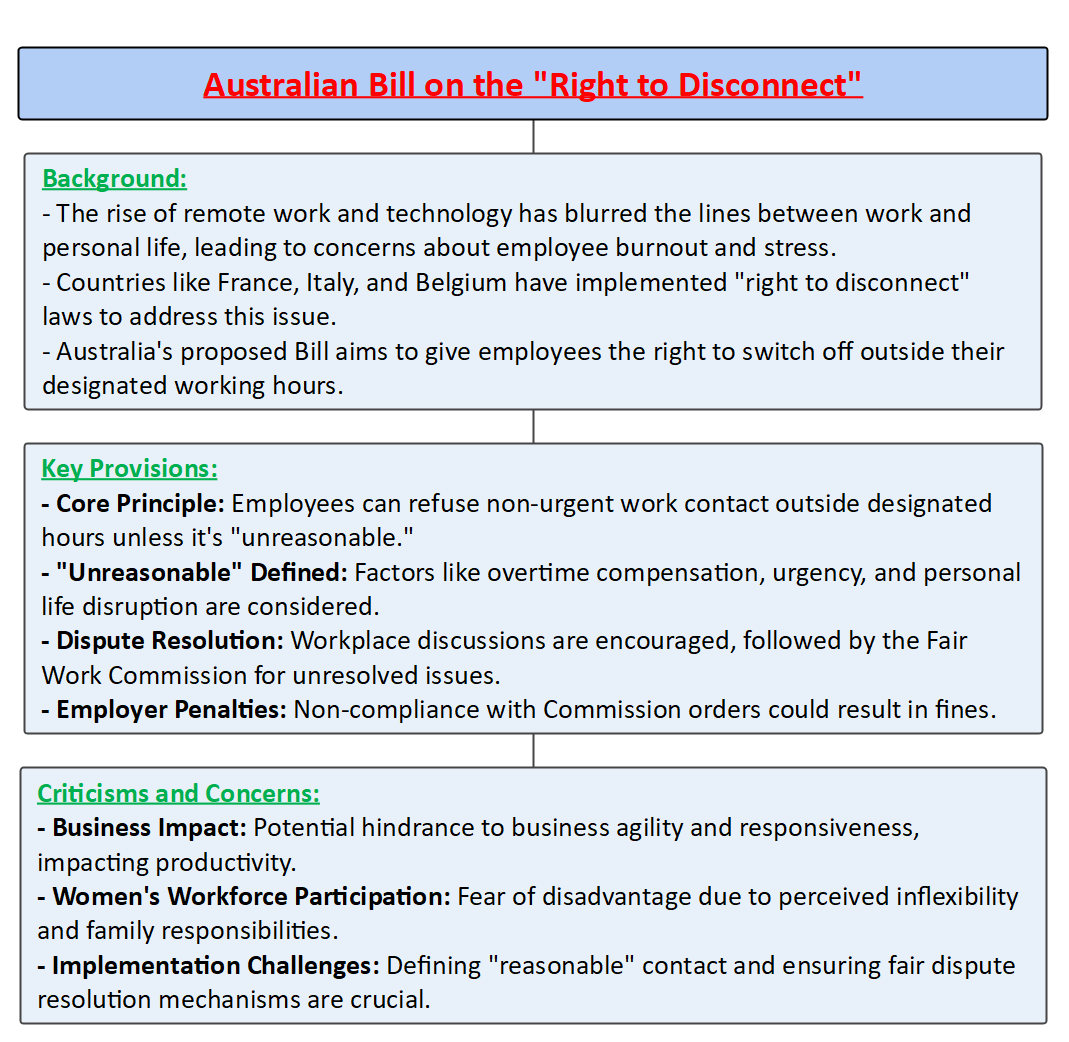Description

Copyright infringement not intended
Picture Courtesy: https://www.linkedin.com/pulse/right-disconnect-unpacking-what-means-employers-fay-calderone-ugxac
Context: Australia's proposed legislation is introducing a "right to disconnect," allowing employees to reject work-related contact outside regular hours unless the request is considered "unreasonable."
Details
- The 'right to disconnect' refers to the concept that employees have the right to be free from work-related communications and tasks outside of their regular working hours. This concept has gained attention as technology enables people to work from anywhere, blurring the lines between work and personal life. Several countries, including France, Italy, and Belgium, have introduced laws to address this issue.
What is the 'Right to Disconnect'?
- Belief and Rationale: Originating from the belief that modern technology, particularly the ability to work remotely, has led to a situation where employees are frequently engaged in work-related activities even outside traditional office hours.
- Australia's Bill: The Australian 'Right to Disconnect' Bill is part of changes to industrial relations laws. It allows employees to refuse to monitor, read, or respond to employer contacts outside working hours unless the refusal is unreasonable. Factors like overtime compensation, the reason for contact, and the level of disruption caused to the employee will be considered to judge the reasonableness of the contact.
- Criticism of the Bill: Critics, including Australia's chambers of commerce, argue that such provisions may make it harder for businesses to operate efficiently and generate wealth for the nation. Concerns are raised that the legislation could impact women's participation in the workforce and create a rigid working environment.
International Examples
- France was the first country to introduce a 'right to disconnect' in 2017. Companies with more than 50 workers are obliged to create a charter specifying hours when staff should not send or answer emails.
- In 2018, an Indian MP drafted a Private Member’s Bill called the Right to Disconnect Bill, although it was not discussed in the House. The proposed bill included the constitution of Employees’ Welfare Committees to negotiate out-of-work hours with employers.

Criticisms of the 'Right to Disconnect'
- Impact on Business Operations: Critics argue that such laws may make it harder for businesses to operate efficiently, impacting productivity and economic growth.
- Gender Impact: Concerns are raised that rigid working hour policies may affect women's participation in the workforce, particularly those with family responsibilities.
- Alternatives Proposed: Some suggest that rather than strict regulations, employers should focus on flexibility and offer knowledge workers more autonomy over their availability.
- Implementation Challenges: Critics argue that employees advocating for the right to disconnect might face challenges, including potential promotions and crucial task exclusions.
Alternative Perspectives
- Flexible Work Policies: Some argue for a cultural shift towards flexible work policies, focusing on trust and autonomy for knowledge workers.
- Catalyst for Change: The right to disconnect is seen as a potential catalyst for better policies on work-life balance, encouraging a cultural shift away from overwork.

Conclusion
- The 'right to disconnect' is aimed at addressing the challenges posed by the increasing overlap of work and personal life, driven by modern technology. While it has been implemented in some countries, criticisms centre around potential impacts on businesses and workforce participation, with alternative perspectives advocating for flexibility and cultural shifts in work practices.
Must Read Articles:
India’s First Gig Workers Rights Bill: https://www.iasgyan.in/daily-current-affairs/indias-first-gig-workers-rights-bill
|
PRACTICE QUESTION
Q. How can the "Right to Disconnect" be implemented fairly without hindering organizational productivity and efficiency, especially in fast-paced, competitive industries? Can a true "disconnect" be achieved in roles where constant availability is a core responsibility?
Answer Structure:
●Define what the "Right to Disconnect" means and why it is important for workers' well-being and performance.
●Acknowledge the challenges and trade-offs of implementing it in different industries and roles, and provide some examples of how it might affect organizational productivity and efficiency.
●Discuss some possible solutions or best practices that could balance the needs and expectations of both employers and employees, such as flexible work arrangements, clear communication protocols, or digital tools that enable a smooth transition between work and personal time.
●Evaluate the feasibility and effectiveness of these solutions, and consider the potential benefits and drawbacks for both parties.
●Conclude with a summary of the main points and a recommendation or opinion on how the "Right to Disconnect" can be achieved fairly and realistically.
|

















